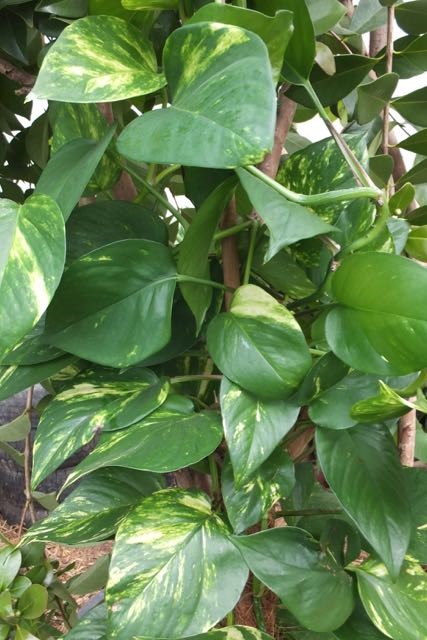
Devil’s Ivy is a robust variegated scrambling climber, not exactly exciting but so very useful. It’s one of those near bomb-proof plants essential in warm greenhouse, frost free conservatory, the home and many an office. A born survivor it puts up with shade and neglect only eventually dying from cold, prolonged drought or severe water-logging. (Though rather annoyingly this can be rooted, and even grown, in water.)
Coming from the Solomon Islands in the Far East this has relations scrambling up trees all over Asia and South America. Discovered and introduced in the 1820s this species soon became popular for it’s sheer dependability and it’s useful trailing/climbing habit. For from a pot or tub situated somewhere convenient this can be trained over many yards of supports making it very handy for concealing pipes and beams. It’s also perfect for clothing bare lower stems and trunks of indoor trees and shrubs especially as it tolerates shade well (though getting better colours in the light).
Theoretically Scindapsus could be grown from seed but it can be so easily multiplied from a cutting or layered and new plants are not expensive. This is fairly happy growing in almost any compost however for the weight of the bottom to balance a free standing plant use a soil based compost in a heavy earthenware pot.
Seldom suffering pests or diseases Scindapsus does not require much care or attention, indeed it prefers neglect to fussing. Obviously liquid feed in the water, say monthly, will benefit, and rain water is best but not essential. Keep just moist in summer, definitely dryish in winter. The leaves can attract dust so would be better for an occasional wipe.
There are improved cultivars such as Marble Queen with pure white variegation and Tricolour with yellow, green and cream variegation. Connoiseurs will also find Scindapsus pictus which comes from Indonesia with waxy dark green leaves overlaid with silver. A half dozen other species have been grown but are increasingly harder to find such as S. siamense from Thailand with heart shaped leaves in green and silvery grey.
What’s in a name? Scindapsus quite aptly comes from the Greek Skindapsos for a plant resembling ivy, and was long known as Pothos or the Ceylon Ivy. It has also been called Raphidophora, however it is now correctly called Epipremnum by botanists, and still known as Scindapsus by everyone else. And why Devil’s Ivy- well that’s lost in the fog of history.


